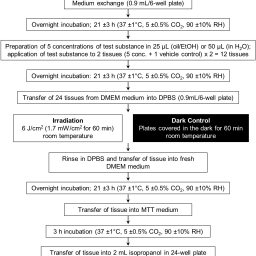Evaluation of phototoxic and cytotoxic potential of TiO2 nanosheets in a 3D reconstructed human skin model
Main Article Content
Abstract
Despite a continuous increase in commercial products containing nanoparticles, only few materials are currently used in such large amounts, forms and sizes as titanium dioxide – TiO2. Besides their use in cosmetics, the food industry and biomedicine, TiO2 nanoparticles (NPs) are also used as highly efficient photocatalysts due to their unique ability to convert complex organic materials to carbon dioxide, water and simple mineral acids via complex radical and electron transfer reactions. We assessed the potential dermal effect (phototoxicity and skin toxicity) of TiO2 nanosheets (TIG-800) synthesized from the lyophilized aqueous colloids of peroxo-polytitanic acid at high temperatures. The nanoparticles were examined in the reconstructed human skin model EpiDerm™ in a test pre-validated by ECVAM and adopted into the ICH S10 guidelines for the preclinical photo-safety assessment of drugs. For comparison, two further commercial samples of nanocrystalline TiO2, Aeroxide P25 and Eusolex T-2000, and six benchmark materials from pre-validation studies were tested. None of the TiO2 NPs tested in the study caused acute phototoxicity or cytotoxicity in the reconstructed 3D tissues up to the highest concentration tested. The prediction of photo-irritation potency for the benchmark chemicals was comparable to previous studies. For some of the tested materials, we identified reasons for false negative results or variability in previously published datasets by improving dosing, conditions of irradiation, and choice of suitable solvents. The method proved its suitability for photo-irritation assessment of topically applied materials.
Article Details

This work is licensed under a Creative Commons Attribution 4.0 International License.
Articles are distributed under the terms of the Creative Commons Attribution 4.0 International license (http://creativecommons.org/licenses/by/4.0/), which permits unrestricted use, distribution and reproduction in any medium, provided the original work is appropriately cited (CC-BY). Copyright on any article in ALTEX is retained by the author(s).


